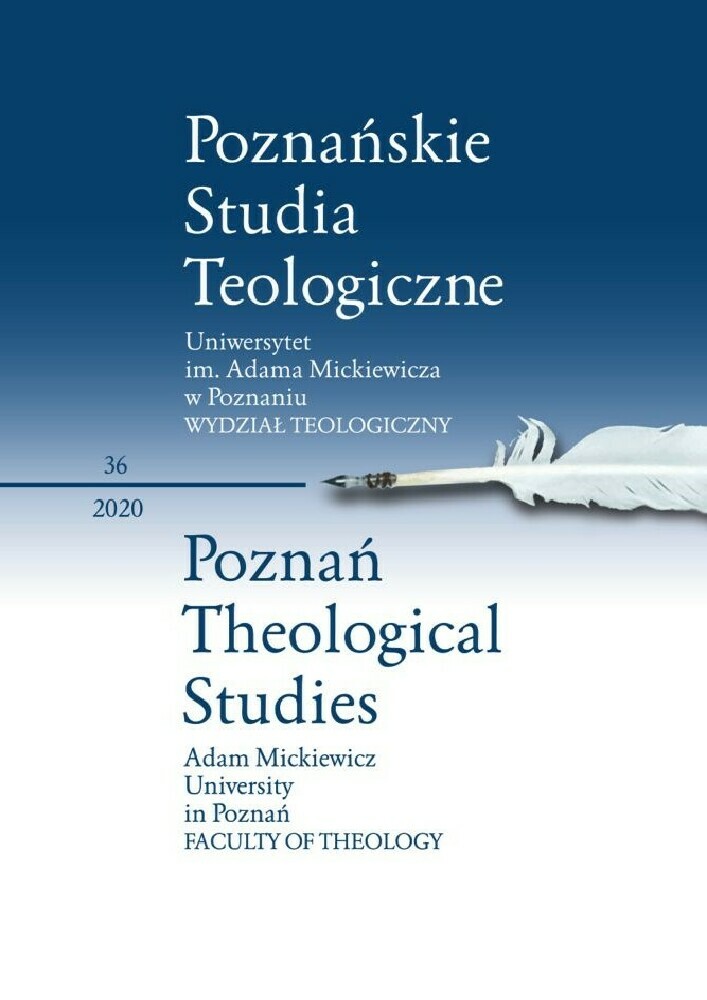Abstrakt
W prezentowanym artykule autor zajmuje się perykopami z warstwy kapłańskiej Pięcioksięgu, w których pojawiają się wzmianki o święcie nowiu księżyca. W pierwszym punkcie podkreśla związki słownictwa hebrajskiego z innymi językami semickimi w kwestii nazewnictwa tegoż święta. Dyskusyjną sprawą jest bowiem tłumaczenie Kpł 23,23–25, w której to perykopie część egzegetów dopatruje się nie święta nowiu księżyca, lecz święta Nowego Roku. Autor przedstawia własną propozycję tłumaczenia tego spornego fragmentu. Dodatkowo zajmuje się problemem hebrajskiego wyrażenia תְּרוּעָה , które pozostawia pewną dowolność interpretacyjną co do sposobu celebracji tego świątecznego dnia. Punktem wyjścia w prezentowanej analizie jest próba nakreślenia trudności związanych z umieszczeniem badanych fragmentów w którejś z warstw. Autor ma zamiar przedstawić propozycje składane przez egzegetów i nie rości sobie prawa do rozsądzania w kwestiach spornych. Punktem zasadniczym jest analiza wymienionych w tytule fragmentów, które autor bada również w odniesieniu do tekstów biblijnych pochodzących z innej warstwy (Deuteronomista) bądź świadectw pozabiblijnych.
Bibliografia
A Concise Dictionary of Akkadian, ed. J. Black, A. George, N. Postgate et al., Wiesbaden 2000.
Ashley T.R., The Book of Numbers, Grand Rapids 1993.
Barcina C., The Conceptualization of the Akitu Under the Sargonids Some Reflection, “State Archive of Assyria Bulletin” 23 (2017), pp. 91–129.
Bibb B.D., Ritual Words and Narrative Words in the Book of Leviticus, (Library of Hebrew Bible/Old Testament Studies 480), New York 2009.
Clines D.J.A. The Evidence for an Autumnal New Year in Pre-Exilic Israel Reconsidered, “Journal of Biblical Literature” 93 (1974) 1, pp. 22–40.
Cole R.D., Numbers, (The New American Commentary 3B), Nashville 2000.
Cooley J.L., Poetic Astronomy in the Ancient Near East: The Reflexes of Celestial Science in Ancient Mesopotamian, Ugaritic, and Israelite Narrative, (History, Archeology, and Culture of the Levant 5), Winona Lake 2013.
Fleming D.E., Time at Emar: The Cultic Calendar and the Rituals from the Diviner’s House, (Mesopotamian Civilisation 11), Winona Lake 2000.
Gesundheit S., Three Times a Year: Studies on Festival Legislation in the Pentateuch, (Forschungen zum Alten Testament 82), Tübingen 2012.
Gorman F.H. Jr., The Ideology of Ritual: Space, Time and Status in the Priestly Theology, (Journal for the Study of the Old Testament Supplement Series 91), Sheffield 1990.
Grabbe L.L., Judaic Religion in the Second Temple Period: Belief and Practice from the Exile to Yavneh, London 2000.
Guillaume P., Land and Calendar: The Priestly Document from Genesis 1 to Joshua 18, (Library of Hebrew Bible/Old Testament Studies 391), New York 2009.
Halayqa I.K.H., A Comparative Lexicon of Ugaritic and Canaanite, (Alter Orient und Alter Testament 340), Münster 2008.
Keel O., Goddesses and Trees, New Moon and Yahweh: Ancient Near East Art and the Hebrew Bible, (Journal of the Study of the Old Testament. Supplement Series 261), Sheffield 1998.
Knierim R., Numbers, Grand Rapids 2005.
Knohl I., The Priestly Torah Versus the Holiness School: Sabbath and the Festivals, “Hebrew Union College Annual” 58 (1987), pp. 65–117.
Lemański J., Pięcioksiąg dzisiaj, (Studia Biblica 4), Kielce 2002.
Levine B.A., Numbers 21–36: A New Translation with Introduction and Commentary, (The Anchor Bible 4A), New Haven–London 2008.
Majewski M., Pięcioksiąg odczytany na nowo. Przesłanie autora kapłańskiego (P) i jego wpływ na powstanie Pięcioksięgu, Kraków 2018.
Martens E.A., Land and Lifestyle [in:] Old Testament Theology: Flowering and Future, ed. B.C. Ollenburger, (Sources for Biblical and Theological Study 1), Winona Lake 2004.
Milgrom J., HR in Leviticus and Elsewhere in the Torah [in:] The Book of Leviticus: Composition and Reception, ed. R. Rendtorff, R.A. Kluger, Leiden 2003, pp. 24–40. Milgrom J., Leviticus 23–27, Philadelphia 1990.
Milgrom J., Numbers, (The JPS Torah Commentary), Philadelphia, PA 1990.
Pardee D.P., Ritual and Cult at Ugarit, (Writings from the Ancient World), Atlanta 2002.
Park S., Pentecost and Sinai: The Festival of Weeks as a Celebration of the Sinai Event, New York 2008.
Pentiuc E.J., West Semitic Vocabulary in the Akkadian Texts from Emar, Winona Lake 2001.
Pizzimenti S., The Other Face of the Moon: Some Hints on the Visual Representation of the Moon on Third-Millennium B.C.E. Mesopotamian Glyptic [in:] Time and History in the Ancient Near East: Proceedings of the 56th Recontre Assyriologique Internationale at Barcelona, ed. L. Felju, J. Llop, A. Millet Alba, J. Sanmartin, Winona Lake 2013, pp. 265–271.
Severino Croatto J., Reading the Pentateuch as Counter-Text: A New Interpretation of Genesis 1:14-19 [in:] Congress Volume Leiden 2004, ed. A. Lemaire, (Supplements to Vetus Testamentum 109), Leiden–Boston 2006, pp. 383–400.
Stackert J., Compositional Strata in the Priestly Sabbath: Exodus 31:12–17 and 35:1–3, “The Journal of Hebrew Scriptures” 11 (2011), pp. 1–20.
Stanek T., Pięcioksiąg jako narracja symboliczna, (Studia i Materiały 170), Poznań 2014.
Steele J.M., The Length of the Month in Mesopotamian Calendars of the First Millenium BC [in:] Calendars and Years: Astronomy and Time in the Ancient Near East, ed. J.M. Steele, Oxford 2007, pp. 133–148.
Van Seters J., The Pentateuch. A Social-Science Commentary, Sheffield 1999.
Wright D.P., Ritual Theory, Ritual Texts, and the Priestly-Holiness Writings of the Pentateuch [in:] Social Theory and the Study of Israelite Religion: Essays in Retrospect and Prospect, ed. S.M. Olyan, (Resources for Biblical Study 71), Atlanta, GA 2012, pp. 195–216.
Yakubovich I., Anatolian Names in –wiya and the Structure of Empire Luwian Onomastic [in:] Luwian Identities: Culture, Language and Religion Between Anatolia and the Aegean, ed. A. Mouton, I. Rutherford, I. Yakubovich, (Culture and History of the Ancient Near East 64), Leiden 2013, pp. 87–124.
Licencja
© 2020 Uniwersytet im. Adama Mickiewicza w Poznaniu, Wydawnictwo Naukowe UAM, Poznań
OPEN ACCESS

